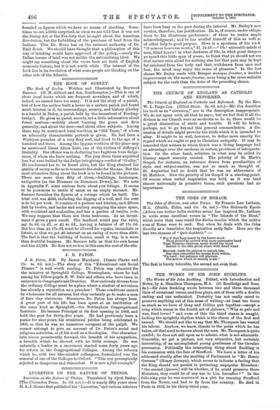Ilia. BOOK OF GORLEY.
The Book of Gorley. Written and Illustrated by Heywood Sumner. (H. M. Gilbert and Son, Southampton.)—This is one of those local books which are frequent nowadays, and of which, indeed, we cannot have too many. It is not the story of a parish, but of how the author built a house in a certain parish and found much interest in it, its surroundings, scenery, and history (Gorley is a hamlet in lbsley, a parish held by the incumbent of Fording- bridge). He gives us parish records, not a little information about forest matters—notably about burning the gorse and fires generally, and about the deer—and about other subjects. Among these may be mentioned local worthies, as "Old Tame," of whom an admirably characteristic portrait is given. He had been a Wesleyan preacher of a very fiery sort, and lived to the age of a hundred and three. Among the bygone worthies of the place may be mentioned Dame Alicia Lisle, one of the victims of Jeffreys's brutality. Her offence was in sheltering two fugitives from Sedge- moor, of whom she knew nothing. The jury three times acquitted her, but were bullied by the Judge into giving a verdict of "Guilty." He condemned her to be burnt alive, but the King strained his quality of mercy so far as to commute the stake for the axe. But the most attractive thing about the book is to be found in the pictures. There are more than fifty of them,—buildings, landscapes, antiquities (as the Mizmaze on Breamore Down), &c. We note in Appendix V. some curious facts about yew foliage. It seems to be poisonous to cattle if eaten on an empty stomach. Mr. Sumner furnishes the figures of a cottage which he built. The total cost was £233, including the digging of a well, and the rent is 3s. 6d. per week. It consists of a parlour and kitchen, each fifteen feet by twelve, and larder and scullery occupying the same space, with woodshed and coal-cellar, and has a garden of twelve rods. We may suppose that -there are three bedrooms. As an invest- ment it gives a poor result. The landlord would pay the rates, say 3s. 6d. on £7, or .21 4s. 6d., leaving a balance of £7 17s. 6d. Not less than £1 17s. 6d. must be allowed for repairs, immediate or future, so that we get £6 interest on an outlay of more than £200. The fact is that the building of houses, small or big, is a more than doubtful business. Mr. Sumner tells us that his own house cost him .22,964. He does not reckon in this sum the cost of the site.


























































 Previous page
Previous page